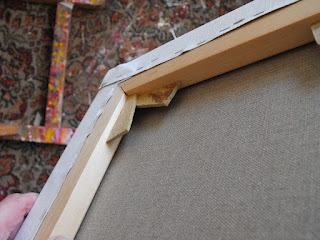I thought I'd say a word about my canvasses.
With conservation in mind, it is good practice to use the best possible support for an oil painting, especially when you hope that it will last for perhaps a few hundred years!
Because of the textural quality of my work, I use Belgian linen canvas rather than cotton duck, as it is a better support for thicker paint and longer lasting. I have my canvasses made for me by Bird and Davis in London.
This is the back of the canvas, where you can see the natural colour and texture or 'tooth' of the linen.
The lengths of canvas are put on to wooden stretchers. The stretchers keep the canvas taught, giving an even, springy surface tension on which to apply the paint. Triangular-shaped wooden keys at the corners can be tapped in with a hammer to open up the joints of the stretchers, in order to further tension the canvas.
On a big canvas, there will also be one or even two cross-bars at the back to further strengthen and stabliise the canvas. These, too, have keys to widen the joints and tension the canvas.
The stretchers are not the same on both sides. One side is flat, one side has a slight camber to it. This is so that the flat surface of the stretchers doesn't sit directly against the canvas, and a slight gap is created.
See the shadow of the slight gap there?
If you're buying your own stretchers to make up your own canvasses, watch out for this. Take a look at the profile of the stretchers and check that they are all round the right way, and that they are being placed with the correct profile to the back of the canvas. The correct order when you're going to attach a canvas to your stretchers is to have canvas with unprimed side facing you, and then place stretchers on top with the flat side facing you.
Watchout for cheap stretchers which have knots in them - these compromise the strength of the stretchers, can also weep an unpleasant piney residue, and cause problems when pinning.
Check the you have right angles on the stretchers - you can either do it the hard way, by measuring you have equal diagonal measurements, or the simple way, by holding a one of those plastic right angles out of your old geometry set in to the corners. Then stretch and pin.
The canvasses are pre-primed. Priming the canvas, first with a glue-like size (traditionally made from rabbit skin) and then with a white ground, stops the paint from reaching the fibres of the canvas and rotting them (although artist such as Francis Bacon painted on the unprimed side of the canvas).
This is the joint at the corner with the keys. It's a work of art in itself!
You can see why I get someone else to do it for me. It's time consuming to get it just right, and it needs to be just right, so I leave it to the experts!



If you want to decompress the entirety of your back, then you may need to invest in an inversion table and some yoga instead of just a stretcher. But that does not mean that a stretcher cannot be effective on its own.For more information visit here; https://bodyeveryday.com/best-back-stretcher/
ReplyDelete